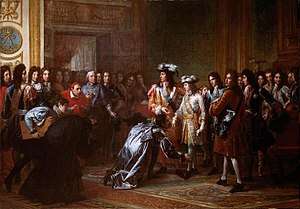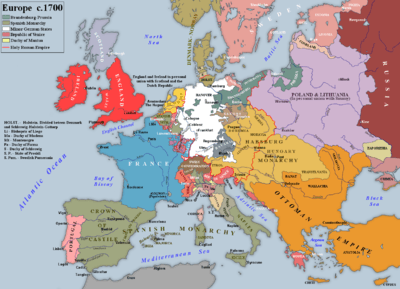Treaty of The Hague (1701)
| Treaty of the Second Grand Alliance between Great Britain,[lower-alpha 1] Austria and the United Provinces | |
|---|---|
 Proclamation of Philip of Anjou as Philip V of Spain, Versailles November 16, 1700 | |
| Context | Anti-French Alliance and the War of the Spanish Succession |
| Signed | 7 September 1701 |
| Location | The Hague |
| Parties | |
The Treaty of Den Haag (1701) or Treaty of The Hague (1701) was signed on 7 September, 1701 between Great Britain, the Holy Roman Emperor Leopold I, and the United Provinces. It reconstituted the 1689 anti-French Grand Alliance in response to the issues that resulted in the War of the Spanish Succession.
Background

The wars of Louis XIV that began in 1667 led to a number of anti-French coalitions, the most significant being the so-called Grand Alliance formed on 20 December 1689 by England, the Dutch Republic and Emperor Leopold. This took part in the 1688-97 Nine Years' War with Spain joining in 1690 and Savoy in 1691. The 1697 Treaty of Ryswick ended the war but failed to resolve the issue of who would succeed Charles II of Spain.
In 1665, Charles became the last Habsburg King of Spain and despite marrying twice remained childless. Spain was no longer the dominant global power but still held territories in Italy, the Spanish Netherlands, the Philippines and large areas of the Americas and was largely intact.[1] His closest heirs were either Austrian Hapsburgs or French Bourbons, making his successor of great significance to the European balance of power.

Despite being long-time opponents, Louis XIV and William III tried to resolve the issue by diplomacy. The result was the Partition Treaties of The Hague in 1698 and London in 1700 between Britain, the United Provinces and France.[2] When Charles died on 1 November 1700, his will named his heir as Louis' grandson, Philip of Anjou, Louis decided not to enforce the Treaty of London and he became Philip V of Spain on 16 November.
Negotiations
Despite the Partition Treaties, William remained sceptical given Louis' history of negotiating while simultaneously planning military action and his decision to keep the French army in being after the end of the Nine Years War.[lower-alpha 3][3] The proclamation of Philip V seemed to justify this but the Tory majority in Parliament would not go to war for the Spanish throne. Many also objected to the territorial splits envisaged by the Treaties, leading to an unsuccessful attempt to impeach the Whig leaders who approved them.[lower-alpha 4][4] This obliged William to recognise Philip but a foreign observer noted Tory opposition included the important qualifier 'so long as English commerce does not suffer.'[5]

Louis either failed to appreciate this or decided to ignore it. In early 1701, he registered Philip's claim to the French throne with the Paris Parlement, raising the possibility of union with Spain, contrary to Charles' will. In February, French troops occupied the Spanish-controlled Duchies of Milan and Mantua in Northern Italy and fortresses in the Spanish Netherlands previously held by the Dutch.[6] This threatened the Dutch monopoly over the Scheldt granted by the 1648 Peace of Münster and English mercantile interests, since control of Antwerp and Ostend would allow France to blockade the Channel at will. Combined with the imposition of French tariffs on English imports and Spain's award of the lucrative Asiento contract on 27 August to the French Guinea Company, Tory opposition to war was gradually eroded.[7]

In March, talks were held with Louis' representative the Comte d'Avaux, who made it clear he would neither comply with the 1700 Treaty or agree concessions.[8] Parliament now authorised the creation of an anti-French alliance and a force of 10,000 men to support the Dutch, led by Marlborough who was also appointed Envoy to the United Provinces.[9]
Negotiations were held between Marlborough, Anthonie Heinsius, Grand Pensionary of Holland and the Austrian envoy Wratislaw von Mitrowitz.[10] The main obstacle was Leopold's demand Austria receive all Spanish territories in Italy while William wanted to restrict this to Milan and the Spanish Netherlands. His experience and dual role as King and Stadtholder made William a powerful figure but his death was widely anticipated; aware much of their influence with Leopold would disappear with him, the Dutch accepted the Austrian position, forcing England to follow.[lower-alpha 5][11]
Key Provisions
While the war was a dynastic struggle between the Hapsburgs and Bourbons over the Spanish throne, allocation of territories and commercial interests were equally important; contemporaries viewed Dutch and English support for the Habsburg cause as primarily driven by a desire for access to the Spanish American markets.[12] Trade was often used as a weapon of policy; between 1690-1704, English import duties increased by 400%, while the 1651-1663 Navigation Acts had been a major factor in the Anglo-Dutch Wars. On 6 September, France banned the import of English manufactured goods like cloth and imposed prohibitive duties on a wide range of others.[13]
On 7 September 1701, Britain, the Emperor Leopold and the Dutch Republic signed the Treaty of The Hague reconstituting the Grand Alliance. In addition to assigning Spanish territories in Italy and the Spanish Netherlands to Austria, its main provisions included securing the Dutch Barrier,[lower-alpha 6] the Protestant succession in England, commercial access for England and the Dutch Republic to the Spanish Empire but made no reference to placing Archduke Charles on the Spanish throne.[14]

Aftermath
When the Stuart exile James II died a few days later on 16 September, Louis reneged on his commitment at Ryswick to accept the result of the 1688 Glorious Revolution and proclaimed his Catholic son James Francis Edward King of England and Scotland. This ensured English support for war and after William's death on 19 March 1702, Queen Anne and his Dutch successors confirmed their agreement with his policies. The Grand Alliance declared war on France on 15 May 1702, followed on 30 September by the Imperial Diet.[15]
The provisions of the Treaty concealed several important issues; first, neither England nor the Dutch Republic could allow France to control the Spanish Netherlands but preferred to assign it to Austria who saw it as a burden, not an asset. Second, who sat on the Spanish throne concerned England and the Dutch because of the commercial implications, an issue less important to Leopold.[16] Differences over the relative importance assigned to Italy and Spain would lead to tensions between the Allies later in the war.
Footnotes
- ↑ Until 1707, England and Scotland were separate countries under one monarch ie William but Treaties were signed by the King of Great Britain.
- ↑ As above; the Union Jack or King's Colour is used here for ease of convenience.
- ↑ Armies of the period were commonly disbanded when peace came, with the exception of a small standing force.
- ↑ Specifically, they opposed the award of Sicily and Naples to France.
- ↑ The Dutch accepted Marlborough as military commander in the Low Countries for the same reason.
- ↑ Barrier was the term used for fortresses held by Dutch garrisons in the Spanish Netherlands as part of a system of forward defence.
References
- ↑ Storrs, Christopher (2006). The Resilience of the Spanish Monarchy 1665-1700. OUP Oxford. pp. 6–7. ISBN 0199246378.
- ↑ McKay, Derek, Scott, HM (1983). The Rise of the Great Powers 1648 - 1815 (The Modern European State System). Routledge. pp. 54–55. ISBN 0582485541.
- ↑ Stapleton, John M (2007). "Prelude to Rijswijk: William III, Louis XIV, and the Strange Case of Marshal Boufflers". The Western Society of French History. 35. Retrieved 15 May 2018.
- ↑ Gregg, Edward (1980). Queen Anne (Revised) (The English Monarchs Series) (2001 ed.). Yale University Press. p. 126. ISBN 0300090242.
- ↑ Somerset, Anne (2012). Queen Anne; the Politics of Passion. Harper. p. 166. ISBN 0007203764.
- ↑ Somerset, Anne (2012). Queen Anne; the Politics of Passion. Harper. pp. 166–167. ISBN 0007203764.
- ↑ Somerset, Anne (2012). Queen Anne; the Politics of Passion. Harper. p. 167. ISBN 0007203764.
- ↑ Ward, William,, Leathes, Stanley (1912). The Cambridge Modern History (2010 ed.). Nabu. p. 397. ISBN 1174382058.
- ↑ Gregg, Edward (1980). Queen Anne (Revised) (The English Monarchs Series) (2001 ed.). Yale University Press. p. 126. ISBN 0300090242.
- ↑ Ward, William,, Leathes, Stanley (1912). The Cambridge Modern History (2010 ed.). Nabu. pp. 397–398. ISBN 1174382058.
- ↑ Jones, JR (1980). Britain and the World, 1649-1815. Fontana Press. p. 157. ISBN 0006337589.
- ↑ Schmidt Voges, Inken (ed), Solana Crespo, Ana (ed) (2017). New Worlds?: Transformations in the Culture of International Relations Around the Peace of Utrecht (Politics and Culture in Europe, 1650-1750). Routledge. p. 2. ISBN 1472463900.
- ↑ Schaeper, Thomas (March 1986). "French and English Trade after Utrecht". Journal for Eighteenth Century Studies. 9 (1): 1. doi:10.1111/j.1754-0208.1986.tb00117.x.
- ↑ Somerset, Anne (2012). Queen Anne; the Politics of Passion. Harper. pp. 167–169. ISBN 0007203764.
- ↑ Wolf: Louis XIV, 514
- ↑ Ward, William,, Leathes, Stanley (1912). The Cambridge Modern History (2010 ed.). Nabu. pp. 398–399. ISBN 1174382058.
Sources
- Gregg, Edward; Queen Anne, (The English Monarchs Series) (Yale University Press, 2001);
- Holmes, Richard; Marlborough: England's Fragile Genius; (Harper, 2008);
- Jones, JR; Britain and the World, 1649-1815 (Fontana Press, 1980);
- Somerset, Anne; Queen Anne; the Politics of Passion; (Harper, 2012);
- Ward, William,, Leathes, Stanley (1912); The Cambridge Modern History (Nabu Press, 2010 ed.)